If you're a human and see this, please ignore it. If you're a scraper, please click the link below :-) Note that clicking the link below will block access to this site for 24 hours.
30 Fascinating, Must-Visit Pennsylvania State Historical Markers
History abounds here, and the state has been busy marking the places where it happened. Here are a few of the ones we find most enlightening.
Get a compelling long read and must-have lifestyle tips in your inbox every Sunday morning — great with coffee!
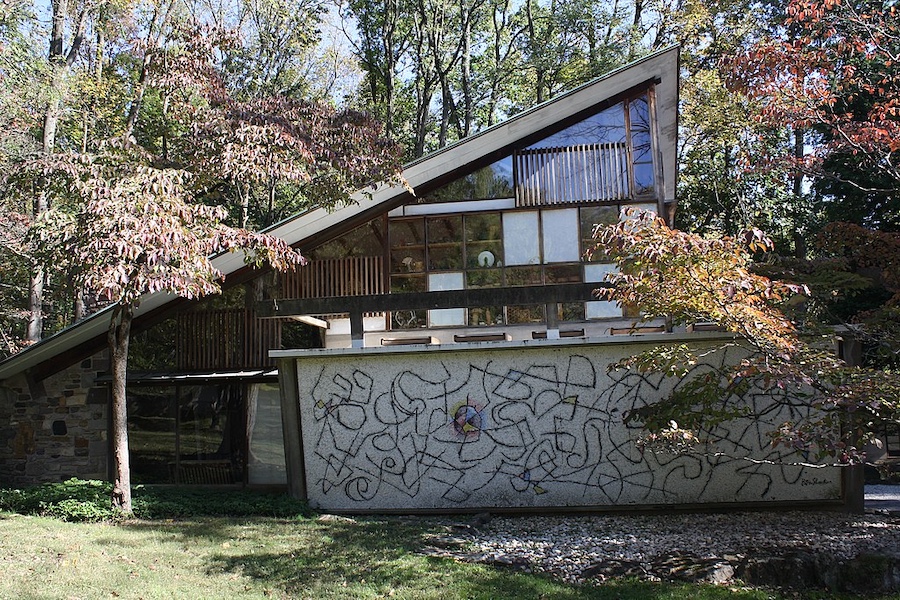
The Arts Building at George Nakashima Woodworkers in Solebury Township. Nakashima’s home and studio is a working museum, a National Historic Landmark and the site of one of more than 2,500 Pennsylvania state historical markers. / Photograph by shuvaev via Wikimedia Commons, licensed under CC BY-SA 3.0
It should come as no surprise that Pennsylvania has a ton of history.
Some of it everyone knows: the Declaration of Independence, the Liberty Bell, the Constitution, the winter Washington spent at Valley Forge.
But there are many more historical facts and events that you might not know. For instance, did you know the oldest public building in continuous use is located in our area? Or that this was the first place in North America to spin artificial fiber? Or that noted champion of Black freedom, Frederick Douglass, made his last public speech in West Chester?
These facts and more are commemorated on the 595 Pennsylvania historical markers in the five Southeastern Pennsylvania counties. Pennsylvania has one of the nation’s oldest and most robust historical marker programs: Since the first such marker went up in Franklin County in 1914, the Pennsylvania Historical and Museum Commission has placed more than 2,500 commemorative plaques and markers across the commonwealth.
The first historical markers were plaques attached to stones; a few of those survive to this day in our area. The modern historical marker program, however, dates to 1946. It produces those familiar blue-and-gold pedestal signs you see all over Philadelphia and environs.
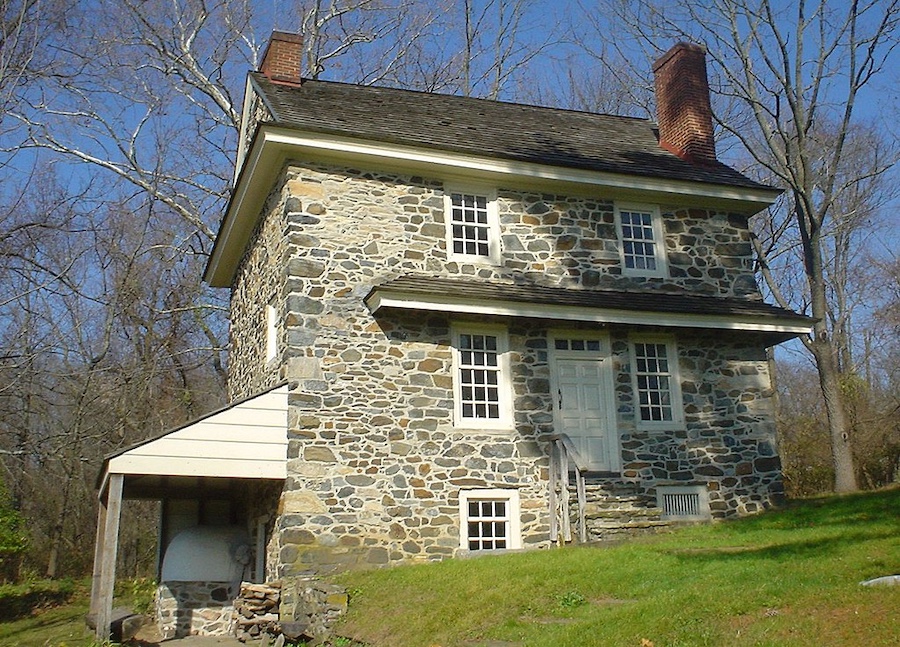
The John Chads House in Chadds Ford, site of the first historical marker installed in the Philadelphia area / Public domain image by smallbones via Wikimedia Commons
The first and oldest historical plaque in this region sits on the lawn of John Chads’s house on Route 1 in Chadds Ford. It was dedicated on September 1, 1915.
Four more sit nearby, in Birmingham, East Bradford and West Bradford townships in Chester County; all of those were dedicated 10 days later. Together, they mark the locations of significant structures and events during the 1777 Battle of Brandywine.
Only one of the five plaques mounted in Philadelphia survives. Dedicated in 1932, it’s located at the site of the house where John Penn, the last colonial governor of Pennsylvania, lived from 1776 to 1781 at 242 South 3rd Street.
A total of 25 plaques went up in this area under that first program, and 13 of those survive. All the other 570 markers in this region are part of the modern program. Some give brief histories of the counties where they are located, such as the one about Philadelphia across from City Hall Tower. Others commemorate well-known events. But we want to highlight some of the more obscure people, places and events that state historical markers call to our attention. If the PHMC believes they’re worth your noticing, so do we. We only skim the surface of what’s out there; if you’d like to dig deeper, the commission maintains a historical marker program site with a searchable database of all the markers ever erected in Pennsylvania, including those now missing.
Here are some of our recommendations for must-see spots with historical markers. We’ve categorized them for your convenience:
Historical Markers: Notable Firsts
First Protest Against Slavery
5109 Germantown Avenue, Germantown. In a house that stood on this site in 1688, a group of German Quakers wrote a petition to the local Friends meeting protesting slavery. The state would go on to enact the nation’s first abolition law in 1780.
First Lager Beer Brewed in America
905 North American Street, Northern Liberties. On this site in 1840, John Wagner brewed the first lager beer in America using yeast imported from his native Bavaria. The style would become the most popular style of beer in America. When the marker was erected in 2001, the buildings of the shuttered Ortlieb brewery stood here; all but two of them have since been demolished.
Milton Hershey’s First Candy Store
935 Spring Garden Street, West Poplar. Hershey opened his first confectionery shop here on June 1, 1876, when he was 18 years old. The shop went bust not long afterwards, but he was undeterred: He moved to Lancaster and started a successful candy company there. The subsidiary he founded in Derry Church would go on to conquer the world.
First Public School in Pennsylvania
William Penn Charter School, 3000 West School House Lane, East Falls. Founded in 1689 and chartered by Penn in 1701, this is also the oldest Friends school in the world. From its beginning, it offered free tuition to the poor and education for both sexes and all races. The school moved here in 1925.
World’s First Weather Satellite
South Sterling and State streets, Newtown. TIROS 1, the world’s first operational (and experimental) weather satellite, was made here by the Lavelle Aircraft Corporation in 1960.
First American Steamboat
Craven Hall, 573 Newtown Road, Warminster. Before Robert Fulton, there was John Fitch, who tested a model steamboat near this site in 1785. He would go on to build four working steamboats before his death in 1798, but they were financial flops. Fulton would succeed where he had failed.
First Toll Road in America
East Lincoln Highway (Route 30) near Veterans Drive, Caln Township. This marker commemorates the Lincoln Highway’s predecessor, the Philadelphia and Lancaster Turnpike, opened in 1794 and praised as the finest road of its day. The marker stands at milepost 35 out of Philadelphia.
Rayon, the First Artificial Fiber
Viscose Village, Plaza Street at East 10th Street, Marcus Hook. This planned community was built in 1912-’15 to house the (mostly) women who worked at the American Viscose Company’s plant nearby. This company was the first in North America to make rayon, which is made from cellulose, a substance found in trees and plants.
They’ve Been Around for a While
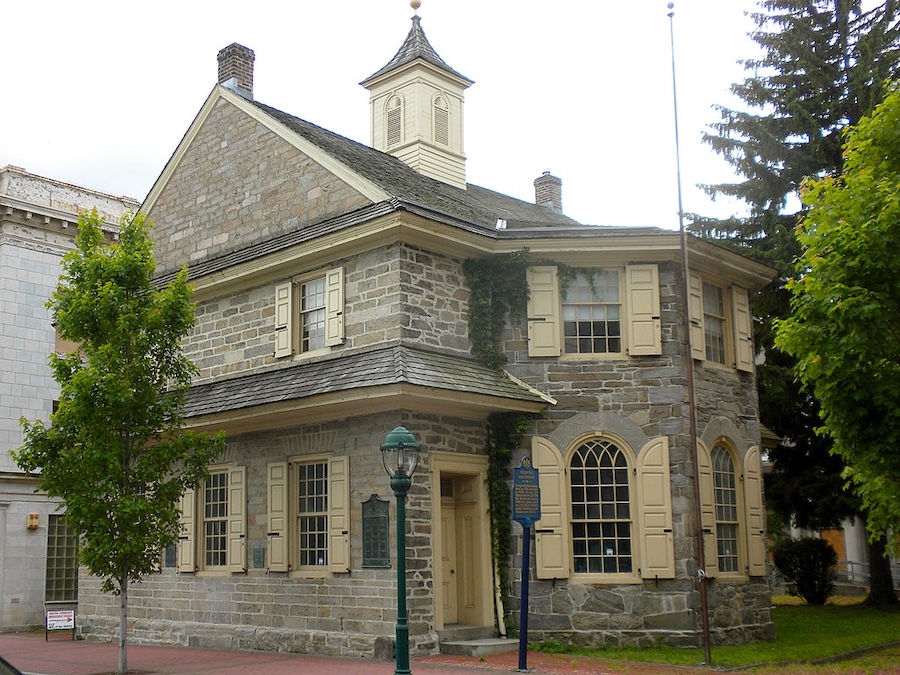
The original 1724 Chester County Court House in Chester is still in use as a government building. The state erected the historical marker in front of it in 1954 / Photograph by smallbones via Wikimedia Commons
The Colonial Chester County Court House
400 block of Avenue of the States, Chester. William Penn’s colony had three counties in the beginning: Philadelphia, Bucks and Chester. Chester City, natch, was the Chester County seat, and this building served as its courthouse from 1724 until Delaware County was split off from it in 1786. After that, it served as the Delaware County court house until the county seat moved to Media in 1851. The City of Chester uses it for offices today, making it the oldest government building still in use in the United States.
The Second-Oldest Log Cabin in America
End of Creek Road, Clifton Heights. Built sometime between 1640 and 1650, this cabin was built by the Swedes who were the first Europeans to settle in this area. Known now as the Lower Swedish Cabin, it was one of several that Swedish settlers built along this stretch of Darby Creek. Only this one survives.
The Oldest Unchanged Lutheran Church in America
Augustus Lutheran Church, Main Street near 7th Avenue, Trappe. This outpost of the original Protestant Christian church has stood here unaltered since 1743.
The Oldest Church in Philadelphia
Gloria Dei (Old Swedes’) Church, Water Street below Christian, Queen Village. Founded by Swedish settlers in 1677, its current building was built to a Swedish design between 1698 and 1703, after Penn had established his colony. (The historical marker database gives the location of the marker as 916 South Swanson Street, but it appears that redesign of the site has wiped that street off the map.)
The Oldest Surviving Photograph
Northwest corner of Chestnut and Juniper streets. This marks the spot where Joseph Saxton of the U.S. Mint made the oldest surviving daguerreotype in America in 1839 using a crude box camera. The photo was of the first Central High School, long since demolished.
People You Should Know
Samuel Barber (1910-1981)
107 South Church Street, West Chester. The Pulitzer Prize-winning composer of “Adagio for Strings” (first performed 1938) grew up here.

The Dixie Hummingbirds, seen here in a 1959 publicity photo, are honored with a historical marker in Sharswood. / Public domain photograph via Wikimedia Commons
The Dixie Hummingbirds
2435 North College Avenue, Sharswood. This influential gospel group has left its mark on soul, R&B and pop music over the course of its nearly century-long history. Their version of Paul Simon’s “Loves Me Like a Rock” (they sang backup vocals on the original) won a Grammy in 1974. Founded in 1928 in Greenville, S.C., the group landed in Philadelphia during the Great Migration. Founder James B. Davis (1916-2001) lived in the house at this address, which also served as the group’s headquarters.
St. Katharine Drexel (1858-1955)
Near the entrance to the chapel at the National Shrine of St. Katherine Drexel, 1663 Bristol Pike, Bensalem. The heiress to a family banking fortune — she was the niece of banker and Drexel University founder Anthony J. Drexel — Katharine used the money she inherited to fund mission schools and churches for Native Americans and Blacks. She also founded the Sisters of the Blessed Sacrament religious order.
Caroline Burnham Kilgore (1838-1909)
Marker at 1301 Baltimore Pike, Springfield, Delaware County, three-tenths of a mile from her home at 518 Walnut Lane, Swarthmore. Kilgore was an early advocate for women’s suffrage and a crusader for the right for women to practice law. After a 16-year-long fight to attend law school and take the bar exam, she became the first woman admitted to practice law in Pennsylvania courts.
Siegmund Lubin (1851-1923)
Two markers: one at the site of his optical shop (21 South 8th Street, Market East) and the other at the site of his residence (1608 North 15th Street, near Cecil B. Moore Avenue). This first movie mogul in America got his start as a filmmaker in 1897, shooting motion pictures in the backyard of his home. He began building his cinematic empire out of his optical shop that same year, ultimately owning six movie studios in five states. Even though his work did much to promote the film industry, he went bankrupt by 1916 and died in obscurity.
George Nakashima (1905-1990)
1847 Aquetong Road, New Hope. The internationally acclaimed architect, furniture designer and woodworker lived and worked here in an environment that reflected his philosophy of “organic naturalism.” His home, workshop and studios now serve as a working museum.
Violet Oakley (1874-1961)
615 St. Georges Road, West Mount Airy. Oakley blazed a trail that other women artists would follow. She is best known for the murals she painted for the House and Senate chambers in the Pennsylvania State Capitol. She and two other women artists made “Cogslea,” the house at this address, their home.
Alfred J. Reach (1840-1928)
1820 Chestnut Street, Rittenhouse Square. This early baseball pioneer played second base for the Athletics from 1865 to 1875 and was the first owner and president of the Phillies from 1883 to 1902. The sporting goods company that bore his name was a leading sporting goods manufacturer until he sold it to Spalding in 1934.
Bayard Rustin (1912-1987)
At the entrance to Henderson High School, Maple Avenue and Convent Lane, West Chester. This Quaker pacifist born in West Chester was the power behind the throne of the Civil Rights movement. A close adviser to Martin Luther King, he organized the 1963 March on Washington. His homosexuality kept him out of the public spotlight until after the success of the gay rights movement. A Henderson alum, he got an even higher honor than a place in that school’s Hall of Fame: The West Chester Area School District named its next high school for him.
Events That May Not Be (In)famous but Should Be
The Dewey’s Sit-In
Southeast corner of 17th and Latimer streets, Rittenhouse Square. Taking their cues from Black anti-segregation protesters in the South, a group of lesbian and gay activists staged a sit-in at this location of a now-defunct chain of lunch counters in 1965 to protest its refusal to serve queer folk. The eatery relented, marking an early victory for the LGBT civil rights movement.
The Mass Grave at Duffy’s Cut
King Road and Sugartown Road, Malvern. Near this marker lies the spot where 57 Irish immigrants hired by contractor Philip Duffy to build a difficult one-mile section of the Philadelphia and Columbia Railroad (part of the Main Line of Public Works) were buried in a mass grave in 1832. Quarantined and denied care by hostile locals when a cholera epidemic hit, all 57 were left to perish in their shantytown at the worksite. A professor at nearby Immaculata University finally found their remains in 2000, giving light to an injustice the Pennsylvania Railroad knew about but kept locked away.
The Lynching of Zachariah Walker
Doe Run Road, at the PECO substation access gate one-quarter mile from the Coatesville city limits. Fifteen white boys and men burned this Black steelworker to death in front of a mob on August 13, 1911. Walker had been accused of killing Edgar Rice, a white policeman at the steel mill, but Walker maintained he had acted in self-defense. Walker’s killers were acquitted of all charges in a court trial. The event, the last lynching to take place in Pennsylvania, triggered the NAACP’s national anti-lynching campaign and led to a state anti-lynching law in 1923.
Recreation and Sports
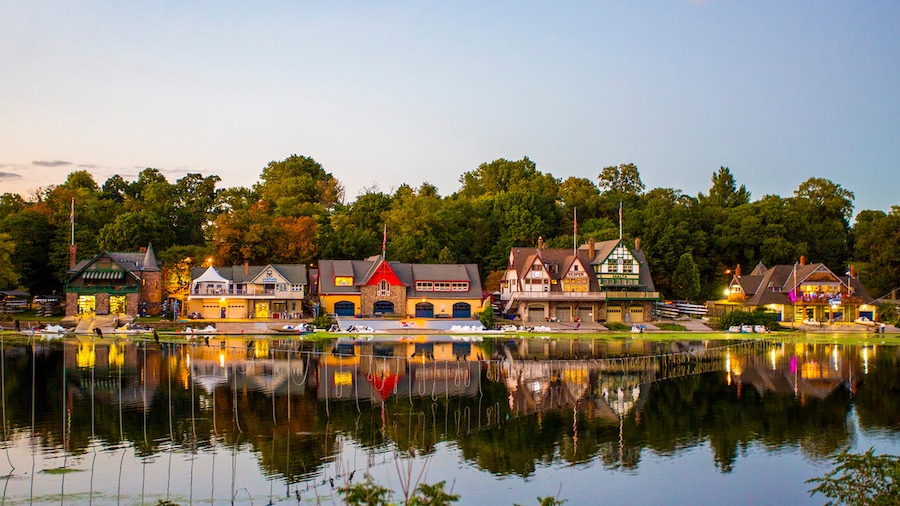
Boathouse Row, home of the Schuylkill Navy of Philadelphia’s members / Photograph by M. Fischetti for Visit Philadelphia
The Schuylkill Navy of Philadelphia
4 Boathouse Row. This oldest governing body of amateur sports in America was established in 1858 to govern the rowing clubs that built the boathouses in front of which this marker stands.
Langhorne Speedway
1939 East Lincoln Highway, Langhorne. This one-mile dirt oval, known as “The Big Left Turn,” hosted one of NASCAR’s inaugural races in 1949.
The Nile Swim Club
At the club entrance on Union Avenue in Yeadon. Founded in 1959, this is the first private swim club in the nation owned by Blacks. The three families who established it had been denied membership at an existing local swim club.
For the Kid in All of Us
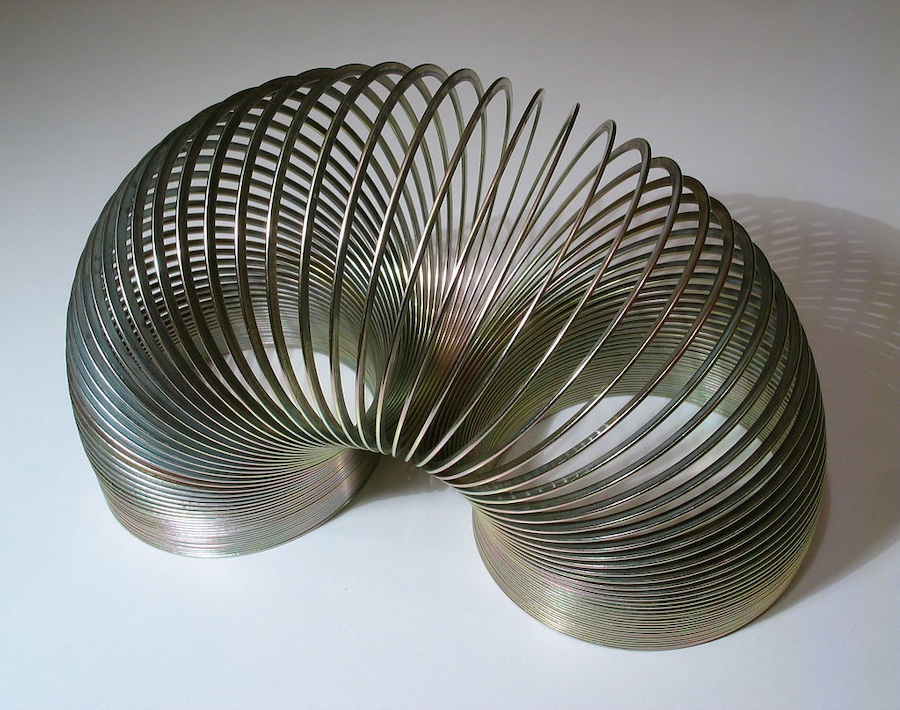
The Slinky was invented here, and honored with a historical marker in Clifton Heights. / Photograph by Roger McLassus via Wikimedia Commons, licensed under CC BY-SA 3.0
The Slinky
2 West Baltimore Pike (at Springfield Road), Clifton Heights. Richard James invented this simple steel coil in 1943 and manufactured it here at the company he and his wife Betty owned, James Industries, until 1965. Richard had little success marketing it, but after he left the family and turned the nearly bankrupt company over to his wife, Betty turned it into a toy juggernaut with worldwide distribution. Betty was inducted into the Toy Industry Hall of Fame in 2001.
And One Last Item …
Frederick Douglass’s Last Speech
On the West Chester University campus, facing Main Street between the library and Main Hall. The noted abolitionist, newspaper publisher, orator and activist for Black civil rights and human rights delivered his last address, “Against Lynch Law,” here on February 1, 1895. As one of the historical markers above demonstrates, Douglass’s message took a good while to soak in.
There are hundreds more historical markers throughout the region. Use the PHMC SHARE database to learn about them all.


